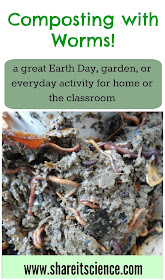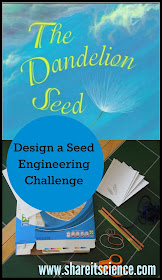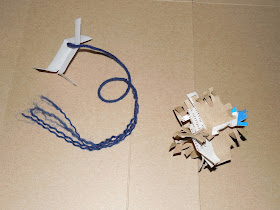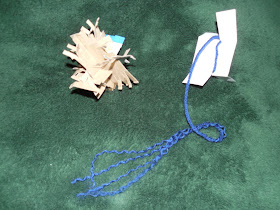Hop on over to Growing
with Science for some fun decomposition and compost critter activities. You’ll
also want to check out this excellent children’s book list on composting and decomposition.
Composting is an excellent activity for children. It’s not only a good environmental practice but there are so many lessons to be learned. How do nutrients get recycled? What is decomposition? What is the difference between insects and other arthropods? Why are worms so helpful?
This post contains affiliate links, meaning I will receive a small commission (at no additional cost to you) if you make a purchase after clicking a product link. Please see disclosures page for more details.
The great thing about compost is that it can be accomplished on a small or large scale. For home gardens and classrooms small scale composting is easy to start and will keep kids engaged throughout the entire year.
Compost Critters by Bianca Lavies This picture book is laden with excellent photographs of the different organisms that work as decomposers. Once you’ve learned about worms, you’ll want to learn more about these other awesome critters as well!
Worms Eat Our Garbage: Classroom Activities for a Better Environment and Worms Eat My Garbage: How to Set Up and Maintain a Worm Composting System, both by Mary Appelhof. These are the quintessential guides to setting up a worm bin and using it as a teaching tool.
Composting is an excellent activity for children. It’s not only a good environmental practice but there are so many lessons to be learned. How do nutrients get recycled? What is decomposition? What is the difference between insects and other arthropods? Why are worms so helpful?
This post contains affiliate links, meaning I will receive a small commission (at no additional cost to you) if you make a purchase after clicking a product link. Please see disclosures page for more details.
The great thing about compost is that it can be accomplished on a small or large scale. For home gardens and classrooms small scale composting is easy to start and will keep kids engaged throughout the entire year.
Worm composting is one excellent way to introduce children to the composting
process. Maintaining a worm bin is simple, it creates little to no odor, and
you will always have a supply of worms for some hands-on learning!
You can easily build your own worm bin, or you can purchase
one. I inherited a Worm-A-Way bin filled with worms when I took on my teaching
job.
 It was an excellent little worm bin and we maintained worms in the classroom with this set-up successfully for 7 years. (When issues arose, it was my fault, which I will explain later!)
It was an excellent little worm bin and we maintained worms in the classroom with this set-up successfully for 7 years. (When issues arose, it was my fault, which I will explain later!)
Building and Populating Your Worm Compost Bin
Currently, this bin is unavailable through Amazon, but you can find many other
alternatives like this one.
If you are interested in building your own bin, like this
one that we keep in our basement at home, it is fairly simple.
 |
| Vermicomposting Bin. Yes! We have worms in our basement! ©SBF 2016 |
To build your own worm bin you will need:
- A plastic storage bin with a lid
- Screening
- Drill, or something to poke ventilation holes
- Rubber stopper
- Shredded paper, or coconut fiber (coir)
- Red wiggler worms that can be purchased here or here (See more on the best worms for a bin below)
We purchased a plastic storage bin and drilled some holes towards the top for ventilation. We also
covered our holes with some screening like this, as an extra precaution for worm escapes,
but under good conditions worms won’t bother traveling.
Drainage is key! We drilled a hole towards the bottom of the
bin to be able to drain liquid out of the composter if necessary. We plugged up
the hole with a rubber stopper. In a household of 2 science teachers, finding a
rubber stopper was easy, but if you don’t have this type of supply readily
available, you can purchase them very inexpensively here. You can see that we weren’t happy with
our first attempt, so we ended up creating a second hole.
Worm bins need to stay damp, but not too wet. This liquid is excellent fertilizer, and any that builds up in your bin needs to be drained out.
Your worms will need some bedding. We use shredded recycled paper or newspaper. If you do this, I recommend trying to avoid using paper with a lot of colors and dye on it. This is a great way to recycle all those pre-approved credit card deals you get in the mail! You can also use peat moss or coconut fiber (coir) as bedding.
Worms aren’t like us; they don’t have teeth to grind their food. Instead worms grind their food with the strong muscles in their gizzard. Your worms will need a bit of garden soil to provide some grit to help them grind their food. Once you have a well-established bin, they will find what they need there and you won’t need to add more soil.
 |
| Ventilation- worms need to breathe too! ©SBF 2016 |
 |
| Two attempts at an effective drainage hole. ©SBF 2016 |
Worm bins need to stay damp, but not too wet. This liquid is excellent fertilizer, and any that builds up in your bin needs to be drained out.
Your worms will need some bedding. We use shredded recycled paper or newspaper. If you do this, I recommend trying to avoid using paper with a lot of colors and dye on it. This is a great way to recycle all those pre-approved credit card deals you get in the mail! You can also use peat moss or coconut fiber (coir) as bedding.
Worms aren’t like us; they don’t have teeth to grind their food. Instead worms grind their food with the strong muscles in their gizzard. Your worms will need a bit of garden soil to provide some grit to help them grind their food. Once you have a well-established bin, they will find what they need there and you won’t need to add more soil.
Choosing Worms for the Worm Bin
Now the most important part: the worms! You can’t put just
any old worm into your bin. Not all worms are suited for recycling waste and
living in this situation. The best worms for small vermicomposting operations
like yours are Eisenia fetida, otherwise known as the red wiggler. These are
epigeic worms, meaning they live in decaying organic material, not soil.
Earthworms that you may find in the soil of your garden are endogeic worms. This means they spend most of their time in the soil among plant roots. Earthworms do not do well in the worm bin! Red wigglers are small worms. You can find them in nature in organic-rich areas like compost heaps and in cow pies.
 |
| Red wigglers! ©SBF 2016 |
Earthworms that you may find in the soil of your garden are endogeic worms. This means they spend most of their time in the soil among plant roots. Earthworms do not do well in the worm bin! Red wigglers are small worms. You can find them in nature in organic-rich areas like compost heaps and in cow pies.
Don’t worry, if you are
not inclined to harvest some worms from a cow pie, you can also purchase
Eisenia fetida from many online retailers or home and garden stores. You can also get them online. Here is one reasonably priced option for live Eisenia fetida. You can also find composting worms on Amazon.
If you know someone who has a healthy worm bin, you can also adopt some of their worms. Once your worm bin is chugging along, you’ll be able to return the favor.
If you know someone who has a healthy worm bin, you can also adopt some of their worms. Once your worm bin is chugging along, you’ll be able to return the favor.
Please note: If you are looking to compost on a large scale, an outdoor
compost bin will serve you better than a small worm composter. Vermicomposting in this sized bin is excellent for small batches of food scraps and for educational purposes.
So you’ve got the bin, and you’ve got the worms. Now what?
I’ve read many times that one pound of worms (about 1,000) can eat up to half a pound of food waste per day. I’ve never tried to count my worms, but even when my worm bin is at its healthiest, it cannot handle half a pound of food waste per day. Balance is key in this micro-ecosystem. The amount of food waste your bin can handle will vary based on a variety of factors.
Worms plow
through food more quickly when it is in smaller pieces. Kitchen scraps work
well. You most likely will find that you’ll need to experiment with your bin to
find the right ratio of food to worms. Start with small amounts once a week, or every few days. Be patient until you find the balance.
You can feed your worms fruit and vegetable scraps, shredded paper, coffee grounds, eggshells, plain rice, pasta or bread. Avoid food scraps that have oils or dressings. Keep dairy products out of your worm bin, as well as meat or bones. Don’t feed them glossy or waxed paper. Never use your worm bin to decompose pet waste, as animal feces can contain harmful bacteria and parasites.
Worms are not difficult to keep alive, however, the
conditions in your bin do need to stay balanced. As I have mentioned before,
worms need to stay moist, but not too wet. Too much moisture is one of the
biggest issues I have run into with vermicomposting.
Your worm bin should never have an unpleasant odor. If it does, it probably means that it is too wet or too much waste has built up. The one time my bin failed was because I did not take the time to empty it and refill with new bedding when I should have. When things went wrong, they went really wrong and the entire bin was a loss.
That said, this won’t happen to you as long as you pay attention to a few things. The first is that you are not overfeeding the worms. When you put food scraps into the bin, cover them with bedding. If those scraps are not gone the next time you go to put food in there, do not throw a lot more in. Once your worms grow in population, you’ll notice the food scraps will go more quickly and you will have a better idea of how much your bin can handle.
If there is any build-up of liquid, simply drain the bin out and add some more bedding (shredded paper or newspaper). This excess moisture can cause worms to drown, food waste to spoil and other unpleasantness. Your bin should never have a foul smell. If it does, then this is most likely your problem.
If your worms begin to jump ship, you also have a problem. Happy worms will stay put where their food and bedding is. If you notice your worms crawling out, or staying high up on the walls of the bin the conditions are not right in there. Check to be sure that it is not too wet, and that it is not dried out in the bin. If wet, drain, and if dry add some bedding that is damp (not dripping!).
You might find over time that you have other critters in your bin. If you use thick bedding and only add scraps fresh from the kitchen (rather than outdoor plant material) you won’t have too many problems. Fruit flies and small white worms in the bin are harmless. If you find you have larger insects, you may want to clear the compost out of the bin (see how below) and add fresh bedding. Some insects can harm your worms.
When the bin begins to fill with worm castings it is time to
harvest your black gold and use it on your garden and houseplants.
Kids love to help with this process. I’ve had students sort through piles of vermicompost and gently put the worms back into the bin and keep the castings out. This does take a while, but if you are working in a classroom it can be a quick process.
If you plan ahead, you can make the bin cleaning process very easy. Scoop the contents of the bin to one side. Put fresh food and bedding on the empty side. The worms will begin to migrate to where the new food and bedding is. Within a week or two the worms will mostly be on the side with the bedding and you can scoop out the compost without losing too many of your wigglers.
It is always handy to have some worms available in your
science classroom or for learning at home. Students can observe their
locomotion and habits. They are useful in teaching how to be gentle and
respectful of living things. Worms are excellent to introduce decomposition and
how the Earth recycles nutrients.
If you scoop out some worms and compost you can challenge kids to make great observations. What do they see in the compost? What parts of the food waste are left behind while others quickly decompose? Can you find a worm egg?
In my experience, I’ve found the following books to be excellent teaching tools and resources:
Feeding Your Worms
I’ve read many times that one pound of worms (about 1,000) can eat up to half a pound of food waste per day. I’ve never tried to count my worms, but even when my worm bin is at its healthiest, it cannot handle half a pound of food waste per day. Balance is key in this micro-ecosystem. The amount of food waste your bin can handle will vary based on a variety of factors.
 |
| ©SBF 2016 |
You can feed your worms fruit and vegetable scraps, shredded paper, coffee grounds, eggshells, plain rice, pasta or bread. Avoid food scraps that have oils or dressings. Keep dairy products out of your worm bin, as well as meat or bones. Don’t feed them glossy or waxed paper. Never use your worm bin to decompose pet waste, as animal feces can contain harmful bacteria and parasites.
Troubleshooting the Worm Bin
Your worm bin should never have an unpleasant odor. If it does, it probably means that it is too wet or too much waste has built up. The one time my bin failed was because I did not take the time to empty it and refill with new bedding when I should have. When things went wrong, they went really wrong and the entire bin was a loss.
That said, this won’t happen to you as long as you pay attention to a few things. The first is that you are not overfeeding the worms. When you put food scraps into the bin, cover them with bedding. If those scraps are not gone the next time you go to put food in there, do not throw a lot more in. Once your worms grow in population, you’ll notice the food scraps will go more quickly and you will have a better idea of how much your bin can handle.
 |
| Our worm bin- in need of some new bedding, but otherwise happy! ©SBF 2016 |
If there is any build-up of liquid, simply drain the bin out and add some more bedding (shredded paper or newspaper). This excess moisture can cause worms to drown, food waste to spoil and other unpleasantness. Your bin should never have a foul smell. If it does, then this is most likely your problem.
If your worms begin to jump ship, you also have a problem. Happy worms will stay put where their food and bedding is. If you notice your worms crawling out, or staying high up on the walls of the bin the conditions are not right in there. Check to be sure that it is not too wet, and that it is not dried out in the bin. If wet, drain, and if dry add some bedding that is damp (not dripping!).
You might find over time that you have other critters in your bin. If you use thick bedding and only add scraps fresh from the kitchen (rather than outdoor plant material) you won’t have too many problems. Fruit flies and small white worms in the bin are harmless. If you find you have larger insects, you may want to clear the compost out of the bin (see how below) and add fresh bedding. Some insects can harm your worms.
Harvesting the Compost
Kids love to help with this process. I’ve had students sort through piles of vermicompost and gently put the worms back into the bin and keep the castings out. This does take a while, but if you are working in a classroom it can be a quick process.
If you plan ahead, you can make the bin cleaning process very easy. Scoop the contents of the bin to one side. Put fresh food and bedding on the empty side. The worms will begin to migrate to where the new food and bedding is. Within a week or two the worms will mostly be on the side with the bedding and you can scoop out the compost without losing too many of your wigglers.
What Can You Learn from Worms?
If you scoop out some worms and compost you can challenge kids to make great observations. What do they see in the compost? What parts of the food waste are left behind while others quickly decompose? Can you find a worm egg?
 |
| Worm "eggs" or "cocoons". ©SBF 2016 |
In my experience, I’ve found the following books to be excellent teaching tools and resources:
Wiggling Worms at Work by Wendy Pfeffer This book outlines the
importance of worms and the basics of their daily lives in beautiful paper collage
illustrations. Excellent for elementary students!
Diary of a Worm by Doreen Cronin Kids love this book.
It is a humorous fictional story, and gives ample opportunity for comparing a
cartoon worms to real worms. I’ve also used it to create a reader’s theater
activity for second graders.
Compost Critters by Bianca Lavies This picture book is laden with excellent photographs of the different organisms that work as decomposers. Once you’ve learned about worms, you’ll want to learn more about these other awesome critters as well!
Worms Eat Our Garbage: Classroom Activities for a Better Environment and Worms Eat My Garbage: How to Set Up and Maintain a Worm Composting System, both by Mary Appelhof. These are the quintessential guides to setting up a worm bin and using it as a teaching tool.













